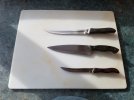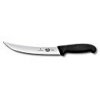- Joined
- Jun 4, 2010
- Messages
- 6,642
I cannot speak to the plastic cutting board being an issue. All mine are hardwood (maple, cherry) and my edges hold up pretty well. I do try to cut at a slight angle so the apex isn't impacting square every time. Plus, for me 10 minutes is the entire amount of cutting for a meal, maybe less. I recently touched up my Dexter chef's knife after about 30-40 minutes work time on the cutting board since it wasn't cutting tomato as cleanly as I like (and keeping in mind 80% of my knife use is chopping w/ the first 2-3 inches of the heel). Before touching it up I dropped an olive on it from about 8" up and it stuck half its depth on the blade.
But...when my kitchen knives dull they don't normally throw back light, and certainly not within a few minutes of use. Your sharpening prep as described sounds solid, so I'd recommend wen you believe you are finished wrap a sheet of dry paper around one of your dry stones - preferably a coarse one - and strop with that, using moderate pressure at the same grind angle.
Then inspect again. This reliably polishes up any latent burrs/wires that might still be hanging around, which I highly suspect is the issue here.
My usual with my softish waterstones is to grind to the apex with the 1k - for a utility edge I might make a leading pass or three on the 1k, followed by a trailing pass or two, and then microbevel with trailing strokes on the 8k, maybe 5 passes - leave lots of tooth.
For a chopping edge I go to the 4k as above and finish trailing passes on the 8k maybe 10 passes or so to get a finer edge. Then normally strop on paper as part of QC, just a few passes.
This method changes based on the stones I'm using but the basic stays the same. If diamond plates I normally run to a coarse or fine and then microbevel with leading pass only on an extra fine or e-extra fine. If using my Juuma stones I'll finish with only leading passes on the 800 or 2k and go right to a Suehiro Rika 8k. That stone is hard enough I can do a few leading passes and then finish with a couple trailing ones. All depends on how hard the stone is.
Occasionally I will just use a Norton Crystalon, grind the edge to a fine and reclaim the mud on a sheet of paper - strop on that in lieu of a microbevel to make a fast and uber grabby edge that can still shave arm hair.
Maintenance for all is on a hard strop (paper over stone or Washboard strop) with blend of SiC and diamond or the reclaimed grit from a Crystalon stone.
But...when my kitchen knives dull they don't normally throw back light, and certainly not within a few minutes of use. Your sharpening prep as described sounds solid, so I'd recommend wen you believe you are finished wrap a sheet of dry paper around one of your dry stones - preferably a coarse one - and strop with that, using moderate pressure at the same grind angle.
Then inspect again. This reliably polishes up any latent burrs/wires that might still be hanging around, which I highly suspect is the issue here.
My usual with my softish waterstones is to grind to the apex with the 1k - for a utility edge I might make a leading pass or three on the 1k, followed by a trailing pass or two, and then microbevel with trailing strokes on the 8k, maybe 5 passes - leave lots of tooth.
For a chopping edge I go to the 4k as above and finish trailing passes on the 8k maybe 10 passes or so to get a finer edge. Then normally strop on paper as part of QC, just a few passes.
This method changes based on the stones I'm using but the basic stays the same. If diamond plates I normally run to a coarse or fine and then microbevel with leading pass only on an extra fine or e-extra fine. If using my Juuma stones I'll finish with only leading passes on the 800 or 2k and go right to a Suehiro Rika 8k. That stone is hard enough I can do a few leading passes and then finish with a couple trailing ones. All depends on how hard the stone is.
Occasionally I will just use a Norton Crystalon, grind the edge to a fine and reclaim the mud on a sheet of paper - strop on that in lieu of a microbevel to make a fast and uber grabby edge that can still shave arm hair.
Maintenance for all is on a hard strop (paper over stone or Washboard strop) with blend of SiC and diamond or the reclaimed grit from a Crystalon stone.


